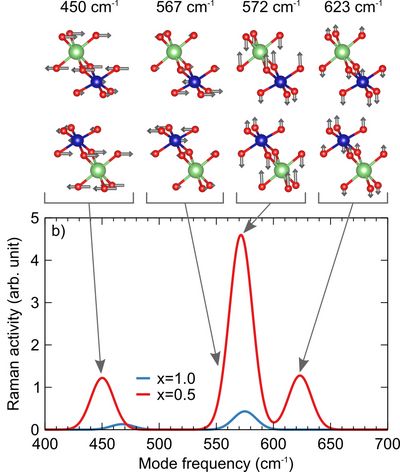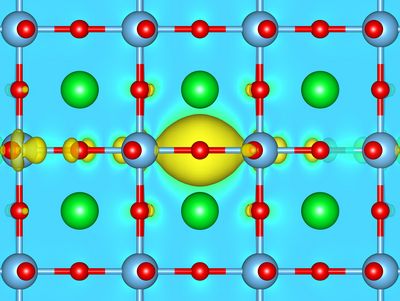MATERIALS SCIENCE AND CHEMISTRY
DEFMAT: Defect Chemistry in Electrochemical Materials
Principal Investigator:
Ulrich Aschauer
Affiliation:
Department of Chemistry and Biochemistry, University of Bern, Switzerland
Local Project ID:
pn69fu
HPC Platform used:
SuperMUC of LRZ
Date published:
Defects are always present in materials and in many cases determine their functional properties. For example, the unconventional superconductivity in SrTiO3 (the ability of a material to conduct electricity without resistance) or the charging and discharging of lithium-ion batteries rely on atomic vacancies (missing atoms), oxygen vacancies in the former and lithium vacancies in the latter case. Despite their abundance and their importance for applications, the quantum-mechanical computation of the electronic structure of defects still represents a considerable challenge. This is due to the fact that often large volumes with many atoms need to be calculated, that defects break the symmetry of the material, requiring sampling of many structural permutations, while, at the same time, highly accurate and therefore computationally intensive approaches are required. This last statement is particularly true for transition metal oxides that are crucial for many applications and that were the focus of the DEFMAT project. These challenges can be tackled by increased computational power, improved methods or a combination thereof.
The project DEFMAT used resources awarded via the Partnership for Advanced Computing in Europe (PRACE) and provided by SuperMUC at the Leibniz Supercomputing Center to carry out density functional theory (DFT) defect calculations of materials relevant in energy applications. As such the team calculated Raman spectra of LiCoO2 that, in conjunction with experimental measurements of these spectra, allow to follow the structural evolution during charging and discharging of this important class of lithium-ion battery cathode materials and to understand what can lead to their failure. The main challenge was to perform these computationally costly calculations at a speed compatible with the experimental investigation, for which SuperMUC was an ideal resource.
The team also calculated the effect of defects forming on a dissolving metastable surface on the (photo)electrocatalytic performance. The extensive sampling of many defect configurations on surfaces of different materials could only be carried out due to access to advanced supercomputing resources. The obtained results reveal that the right defect configurations can result in sites with very high catalytic activities. This opens the path towards a more targeted design of defective surfaces with high catalytic activity, exploiting this so-called activity-stability relation.
Finally, the team also worked on novel computational methods applied to defects that will enable DFT calculations of defects with a similar accuracy than state-of-the-art methods, however at a much-reduced computational cost. This will either allow for faster turn-around times or the ability to tackle larger calculations in the future. The SuperMUC resources were used to develop and benchmark a self-consistent and site-dependent DFT+U(+V) approach that properly captures the altered atomic environment around a defect. The extremely good performance of the code allowed the team to use a large number of nodes on SuperMUC to validate the approach also for very large volumes. The developed approach has the potential to play an important role in future defect calculations as shown by the large interest of the scientific community.
All results obtained by the DEFMAT project were published in leading chemistry and physics journals.
Publications supported by the project
Vonrüti N., Aschauer U., "Band-gap engineering in AB(OxS1-x)3 perovskite oxysulfides: a route to strongly polar materials for photocatalytic water splitting", J. Mat. Chem A, 7, 15741, 2019
Ricca C., Timrov I., Cococcioni M., Marzari N., Aschauer U., "Self-consistent site-dependent DFT+U study of stoichiometric and defective SrMnO3", Phys. Rev. B, 99, 094102, 2019
Vonrüti N., Aschauer U., "The role of metastability in enhancing water-oxidation activity", PCCP, 21, 24354-24360, 2019
Flores E., Novák P., Aschauer U., Berg E., "Cation ordering and redox chemistry of layered Ni-rich NCMs: an operando Raman spectroscopy study", Chem. Mater., in press, DOI: 10.1021/acs.chemmater.9b03202
Bouri M., Aschauer U., "Density functional theory study of the oxygen evolution activity on Sr2TaO3N surfaces", Chem. Mater, in press, DOI: 10.1021/acs.chemmater.9b02294
Ricca C., Timrov I., Cococcioni M., Marzari N., Aschauer U., "Self-consistent DFT+U+V study of oxygen vacancies in SrTiO3", submitted
Scientific Contact
SNF Prof. Dr. Ulrich Aschauer
Universität Bern
Departement für Chemie und Biochemie
Freiestrasse 3, CH-3012 Bern (Switzerland)
Tel. +41 (0)31 631 5629
e-mail: ulrich.aschauer [@] dcb.unibe.ch
www.dcb.unibe.ch
LRZ project ID: pn69fu
January 2020


